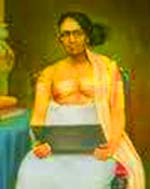Modern translations
Other than the ancient translations which were from the Sanskrit text into Indian languages, there have been modern translations of the epic. The modern age in this context would imply
 |
Kunjikuttan Thampuran |
post-18th century. It is again difficult to give a comprehensive and chronological list of all translations made into the different Indian languages, except to mention a few important ones. One of the most amazing and comprehensive of all is Kodungalloor Kunjikuttan Thampuran’s translation of the entire epic from Sanskrit
into Malayalam verse in the 19th century. His translation was very faithful, as it was rendered metre by metre and word for word. The entire exercise took only 874 days, and it earned him the title of Kerala Vyasa. Kali Prasanna Singh translated it into Bengali (19th century), Pt. Ramnarayandutt Shastri Pandey Ram into Hindi, and Manalur Rangachariar into Tamil.
English translations were also done after the British colonization of India. Romesh Chander Dutt’s version, Mahabharata, the Epic of Ancient India condensed into English Verse was published in 1898. As the title indicates, this was a target-oriented translation that took into consideration the fact that the target readers were not familiar with the linguistic or cultural milieu of the source text. Kisari Mohan Ganguli did the complete translation into English in 11 volumes. P. Lal’s ‘transcreation’ of the epic is justly famous. It is a compendious work as it meticulously includes all slokas in all the known recensions. It was a major project that took Lal years to complete, and was published fully only by 2010. Lal called his translation a ‘transcreation’ because he had added and made his own contributions to the epic while translating it. The Clay Sanskrit Library, which has a project of translating ancient Sanskrit texts, includes the Mahabharata in English (http://www.claysanskritlibrary.org/CES_seduced_sanskrit.php). There have been translations into languages like Russian and French besides English.
|